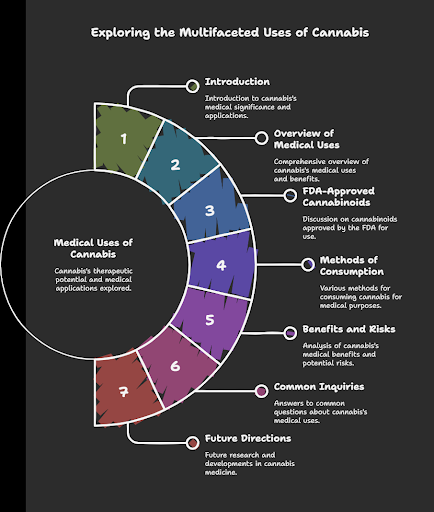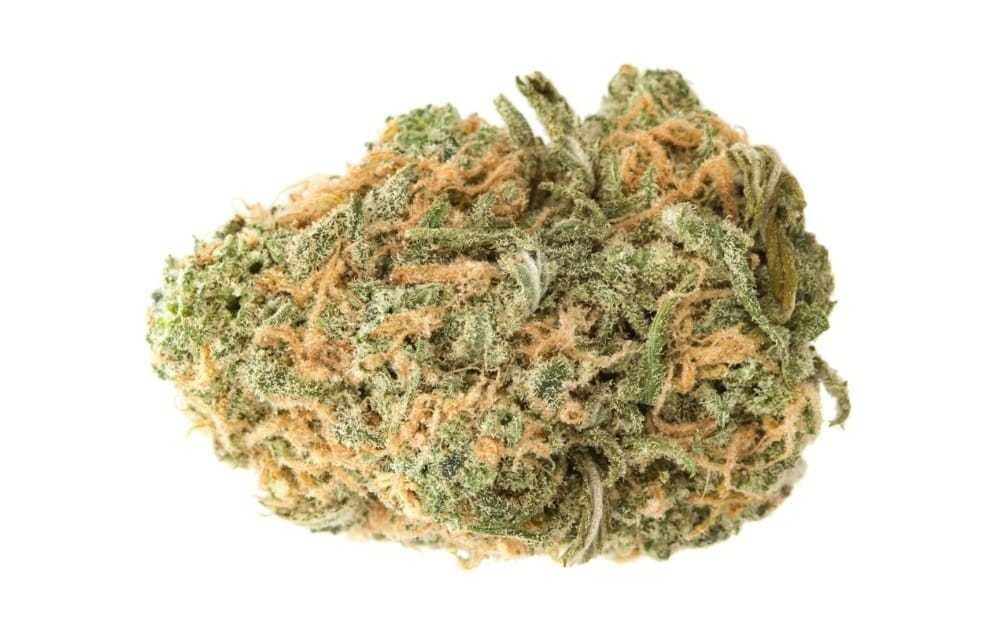Medical Uses of Cannabis: A Comprehensive Guide

Cannabis has shown immense potential in treating various medical conditions. From chronic pain and epilepsy to anxiety and appetite stimulation, cannabis offers a wide range of therapeutic benefits. This article provides a detailed exploration of its medical uses, approved medications, methods of consumption, benefits and risks, and future directions.
Exploring The Multifaceted Uses Of Cannabis
- Introduction
- Overview of Medical Uses of Cannabis
- FDA-Approved Cannabinoids
- Methods of Consumption
- Benefits and Risks
- People Often Ask About the Medical Uses of Cannabis
- Future Directions
- Conclusion
Introduction To Cannabis medical
Cannabis has transitioned from a controversial substance to a recognized option in medicine. Its active compounds, THC and CBD, offer various therapeutic benefits. This article provides a detailed exploration of cannabis’s medical uses, FDA-approved medications, methods of consumption, benefits, risks, and future directions. Whether you’re a patient, caregiver, or simply seeking information, this guide offers valuable insights into medical cannabis.
Overview of Medical Uses of Cannabis
Cannabis has shown potential in treating various medical conditions. Studies highlight its therapeutic benefits for managing symptoms in multiple medical fields
- Pain Management: Cannabis has analgesic properties that may alleviate chronic pain, including neuropathic pain.
- Nausea and Vomiting Relief: Cannabis can mitigate nausea and vomiting, particularly in patients undergoing chemotherapy.
- Spasticity Reduction: Cannabis may help reduce muscle spasms and spasticity, especially in conditions like multiple sclerosis.
- Epilepsy Treatment: Some evidence suggests that cannabis can help reduce seizure frequency in certain types of epilepsy.
- Anxiety and Insomnia: Cannabis may exhibit anxiolytic and sedative effects, potentially aiding in managing anxiety and insomnia.
- Appetite Stimulation: Cannabis can stimulate appetite, which is beneficial for individuals with conditions like HIV/AIDS or cancer experiencing weight loss and wasting syndrome.
- Glaucoma: Some studies suggest that cannabis can help reduce intraocular pressure, a key factor in glaucoma.
- Multiple Sclerosis Management: Cannabis may help manage symptoms associated with multiple sclerosis, such as spasticity and pain.
- Crohn’s Disease: Research indicates that cannabis may help manage symptoms of Crohn’s disease, such as pain and nausea.
- HIV/AIDS Symptom Relief: Cannabis has been used to manage symptoms of HIV/AIDS, including nausea, pain, and loss of appetite.
- Post-Traumatic Stress Disorder (PTSD): Some studies have shown that cannabis may help alleviate symptoms of PTSD.
- Alzheimer’s Disease: Studies suggest that medicinal cannabis can help with symptoms of depression and lack of appetite in patients with Alzheimer’s disease.
- Anorexia Nervosa: Cannabis may help stimulate appetite, which is beneficial for individuals suffering from anorexia nervosa.
- Irritable Bowel Syndrome (IBS): Cannabis has shown effectiveness in relieving symptoms of IBS, such as abdominal pain and bloating.
- Amyotrophic Lateral Sclerosis (ALS): Some ALS patients have reported decreased muscle spasticity, reduced pain, and improved mood and appetite while using cannabis therapeutically.
Important Considerations:
- Research is Ongoing: While there’s growing evidence for the potential medical uses of cannabis, more research is needed to fully understand its effects and potential risks.
- Individual Responses Vary: The effects of cannabis can differ significantly from person to person.
- Potential Side Effects: Cannabis can cause side effects such as dizziness, dry mouth, and cognitive impairment.
- Legal Status: The legality of cannabis varies by location.
- Form of Use: The method of consumption (e.g., smoking, edibles, vaping) can influence its effects.
Not a Cure-All: Cannabis is not a cure for any disease but may help manage certain symptoms.
FDA-Approved Cannabinoids
Several cannabinoids derived from cannabis have been approved for medical use by the Food and Drug Administration (FDA). These medications demonstrate the growing acceptance of cannabis in mainstream healthcare.
Each of these medications addresses specific medical needs, showcasing the versatility of cannabis compounds. For instance, Epidiolex is specifically designed for children with severe epilepsy, while Marinol and Ceramet target nausea and appetite loss in cancer and AIDS patients.
Methods of Consumption
Cannabis can be administered through various methods, each with advantages and drawbacks. The optimal method depends on the condition, personal preference, and legal regulations.
- Smoking:
Smoking cannabis provides rapid relief, as the compounds enter the bloodstream through inhalation. However, it carries risks of respiratory irritation and lung damage.
- Vaporizing:
Vaporizing is a safer alternative to smoking, as it heats cannabis to release its active compounds without combustion. This method offers quick relief with minimal side effects.
- Edibles:
Edibles, such as gummies or brownies, provide long-lasting effects suitable for chronic conditions. However, they require precise dosing, as the effects can take hours to manifest and last longer than expected. - Tinctures/Capsules:
Tinctures and capsules offer consistent and controlled dosages, making them ideal for individuals who need predictable effects. They’re also discreet and easy to use.
- Topical Applications:
Topical cannabis products, such as creams and balms, target localized pain without psychoactive effects. This makes them ideal for conditions like arthritis or skin inflammation.
Medical Cannabis use | Benefits and Risks
Benefits
- Opioid Alternative: It offers a safer alternative to opioids, reducing the risk of addiction and overdose.
- Flexible Consumption: Various consumption methods allow for tailored treatment plans.
- Broad Symptom Relief: Cannabis can address multiple symptoms simultaneously, including pain, nausea, and muscle spasticity.
- Improved Quality of Life: It can significantly enhance mobility and reduce discomfort for patients with conditions like MS or epilepsy.”
Risks
- Side Effects: Common side effects include dizziness, dry mouth, and cognitive impairment.
- Legal Restrictions: The legality of cannabis varies by country and state, limiting access for many patients.
- Dependence Potential: While less addictive than opioids, cannabis can still lead to dependence in some cases.
- Limited Research: Long-term studies on cannabis use are limited, raising concerns about potential side effects over time.
People Often Ask About the Medical Uses of Cannabis
Q: What are the primary medical uses of cannabis?
A: Cannabis is widely recognized for its ability to manage chronic pain, nausea and vomiting (especially from chemotherapy), spasticity, and epilepsy. Some studies also suggest benefits for anxiety, insomnia, and appetite stimulation.
Q: How does cannabis interact with the body’s systems?
A: Cannabis interacts with the body’s endocannabinoid system (ECS) , which regulates physiological processes such as pain, appetite, and mood. THC binds to CB1 receptors in the brain, while CBD interacts with CB2 receptors in the immune system, reducing inflammation and moderating pain signals.
Q: Are there FDA-approved cannabis-based medications?
A: Yes, several cannabis-derived medications are FDA-approved. Examples include Epidiolex (for epilepsy), Marinol (Dronabinol) (for chemotherapy-induced nausea), and Cesamet (Nabilone) (for nausea and vomiting). These medications demonstrate the growing acceptance of cannabis in regulated healthcare.
Q: What are the different methods of consuming cannabis for medical purposes?
A: Cannabis can be consumed through various methods, each with its own advantages and drawbacks:
- Smoking: Provides rapid relief but may cause respiratory irritation.
- Vaporizing: A safer alternative to smoking, offering quick onset with minimal side effects.
- Edibles: Long-lasting effects suitable for chronic conditions but require precise dosing.
- Tinctures/Capsules: Consistent and controlled dosages, making them ideal for predictable relief.
- Topical Applications: Target localized pain without psychoactive effects.
Q: What are the potential risks of using cannabis medicinally?
A: While cannabis offers numerous benefits, it also carries potential risks such as dizziness, dry mouth, and cognitive impairment. Legal restrictions vary by location, and long-term studies are limited, raising concerns about prolonged use.
Q: Is cannabis a cure for diseases?
A: No, cannabis is not a cure for any disease. However, it may help manage certain symptoms such as chronic pain, nausea, and muscle spasticity. Its role is primarily supportive rather than curative.
Future Directions in Medical Cannabis (Updated for 2025)
The research into cannabis continues to expand, with scientists exploring new ways to harness its therapeutic potential. Key areas of focus include:
- Standardized Dosing Protocols: Developing precise dosing guidelines is crucial to ensure safety and efficacy across diverse patient groups. Researchers are working on creating standardized protocols that account for individual variations and specific conditions.
- Long-Term Studies: Investigating the long-term impacts of cannabis use, especially for chronic conditions like multiple sclerosis and epilepsy, remains a priority. These studies aim to provide a more comprehensive understanding of the benefits and potential risks associated with prolonged cannabis use.
- Integration with Conventional Medicine: Exploring how cannabis can complement traditional medical treatments is another important area. This includes research on combining cannabis with existing medications, such as using CBD with antidepressants for improved mental health outcomes.
- Public Awareness Campaigns: Educating the public about the benefits and risks of cannabis is essential to reduce stigma and misinformation. There’s a growing emphasis on developing effective public awareness campaigns to provide accurate information and promote informed decision-making.
.
Conclusion
Cannabis holds immense promise as a medical treatment option. Its ability to address chronic pain, epilepsy, nausea, and muscle spasticity, among other conditions, underscores its potential in modern medicine. While challenges such as legal restrictions and long-term safety remain, ongoing research and patient experiences point toward a future where cannabis plays a prominent role in healthcare.


